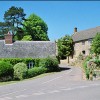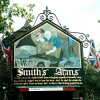Nowadays there are only a few cottages in Bloxworth fighting to be seen amongst the modern housing developments that were causing controversy as long as forty years ago, when Nikolaus Pevsner speaking of Bloxworth complained: “Many of the red brick cottages are derelict, or have already been demolished, and new housing south and west of the church includes some unpleasing showy abodes of Bournemouth commuters.” But it has not always been such. In 1939 Arthur Mee spoke of Bloxworth as being: “as pretty a village as an artist could wish to see, with its thatched cottages scattered among the trees…” and in 1906 Frederick Treves called it: “..the daintiest hamlet…”.
The parish covers a little over 2,800 acres in a narrow strip of land about five miles North, North West of Wareham; it is a wooded area stretching across the northern edge of the south Dorset Heath and bordered by Morden and Bere Regis.
The Church is dedicated to St. Andrew. The reset late 12th century south doorway to the nave and the early cross-head in the vestry suggest there has been a church on this site since before the end of the 12th century. The tower was built in the 14th century and the nave was partly or possibly wholly rebuilt around the same time, though the south wall was refaced and the north wall rebuilt in the late 17th century. The north chapel, known as the Savage Pew, is also of the late 17th century, dating before 1683. Also, the 17th century saw the south porch added, which was restored during the general restoration of 1870 when the vestry was added and the chancel rebuilt to the design of George Evans. It has been described as over-elaborate and is a good example of our Victorian forefathers getting over enthusiastic about their church restorations. The font is from the early 17th century and the tower houses two bells.
Inside the church there are some interesting memorials including some to the Trenchard and Pickering families and there are heraldic paintings of arms belonging to the Savage and Strode families. The Savages were lords of the manor here in the 17th century. Most unusually there remains the original hour glass with stand; after the reformation the length of sermons was limited to one hour (see photo in gallery.)
In the churchyard there is the tomb of Robert Welsteed, who was Rector here from 1597 until his death in November 1651. The inscription reads:
“Here lies that reverend orthodox divine
Grave Mr Weksteed, aged seventy-nine
He was the painful pastor of this place
Fifty-five years compleate, during which space
None justly could his conversation wound
Nor’s doctrine taint, ‘twas so sincere so sound
Thus having his long thread of life well spunne
Twas cutt, November tenth in fifty-one,
1651.”
Another Rector of this parish, John Morton, went on to become Archbishop of Canterbury (see our article: ‘A Cardinal’s Progress – the Life of John Morton of Stileham’ in the Bloxworth Category.)
In 1868 The Reverend Octavius Pickard-Cambridge came to be Rector of Bloxworth in addition to his service to the parish of Winterbourne Tomson. He immediately set about planning the re-building of the chancel as a memorial to his father. He was an expert on spiders and is reputed to have identified in the county 800 species of these creatures and wrote a book about the Spiders of Dorset. After forty-nine years of ministry at Bloxworth he died in 1917.
Of interest also is Samuel Crane who was born at Bere Regis in 1746. (See our article: ‘Samuel Crane – Farmer Diarist of Bloxworth’ in the Bloxworth Category.)
Bloxworth House was home to the Strode family and is essentially a 17th century building of some note. It is occasionally open to the public. There is a story that says there were originally three bells hanging in the church tower but the tenor bell was damaged and the Squire and the Churchwardens had it removed for repair. However, it seems it was sold for sixteen shillings and converted into a large brewing copper, which was installed in Bloxworth House.
Hutchins says life in this parish was hard. Today, it seems that many who live here work elsewhere and possibly enjoy a less physically demanding life-style than that endured by their forefathers.



